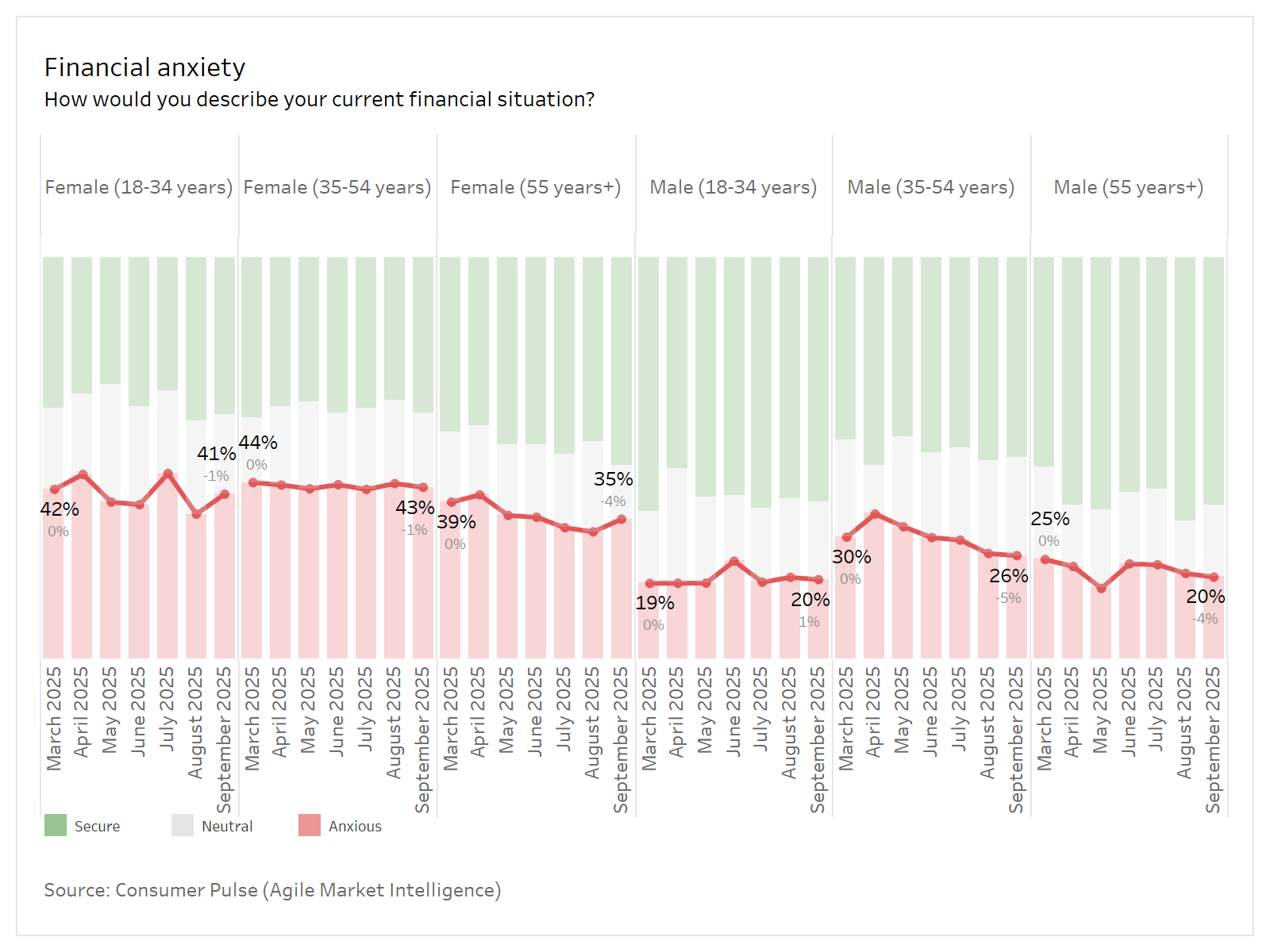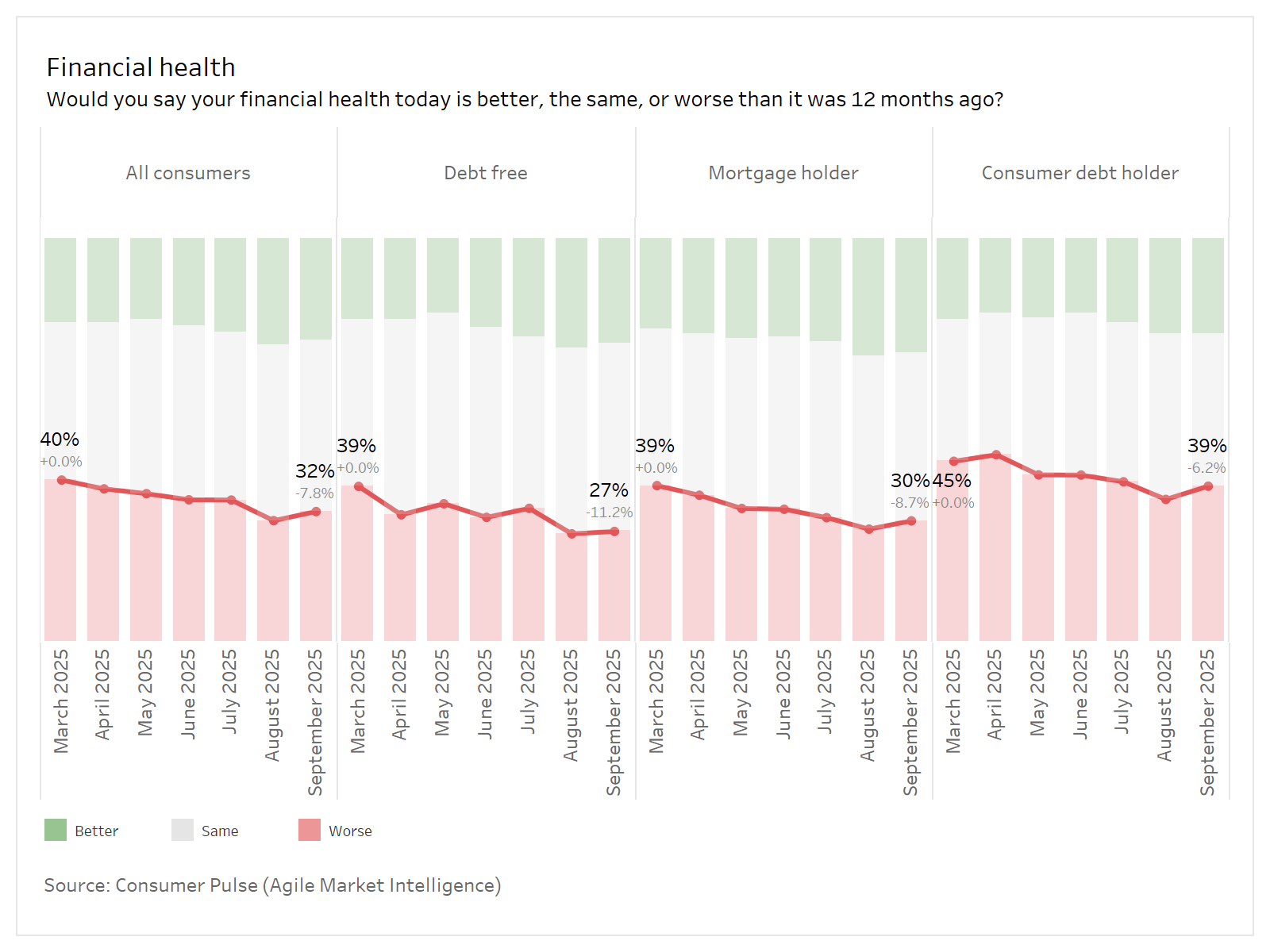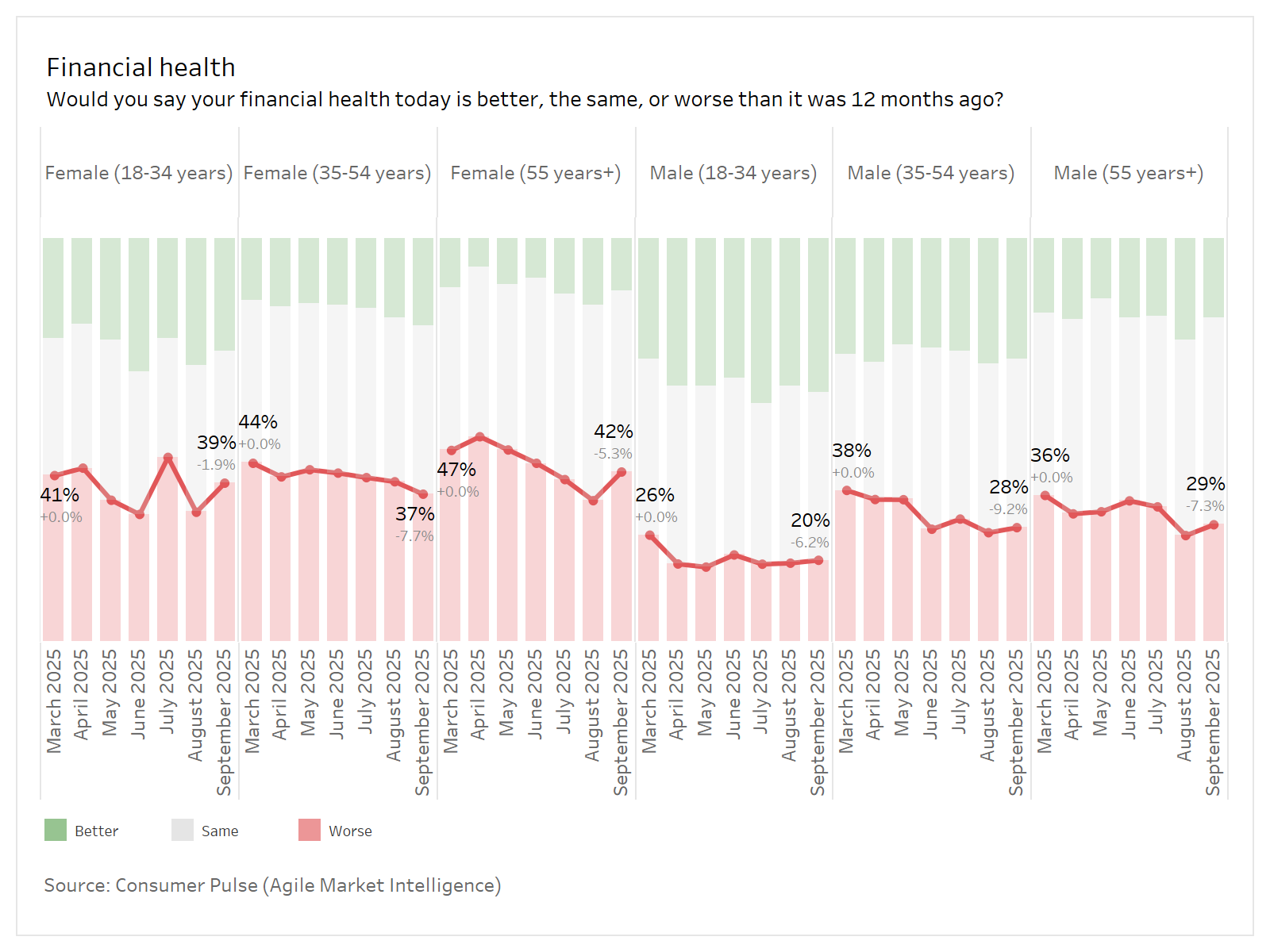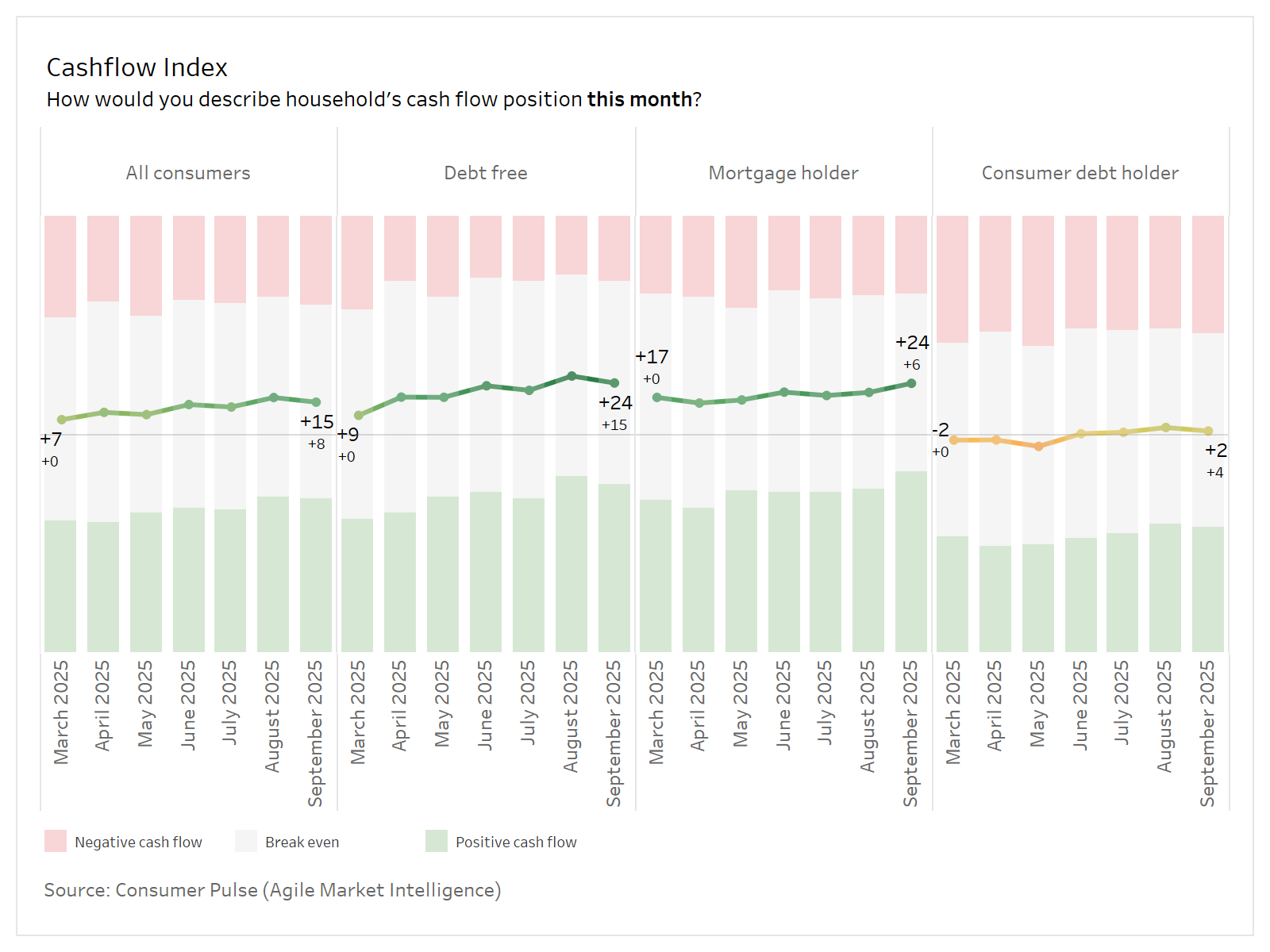
The latest Consumer Pulse data from Agile Market Intelligence reveals Australian household financial sentiment in September 2025, showing signs of improving consumer sentiment with rate cuts taking effect. Consumer Pulse is an always-on survey of Australian consumers to understand their attitudes, experiences and priorities towards their finances and financial institutions.
This program tracks consumer sentiment based on their financial security/anxiety, their perceived financial health relative to a year ago and their reported household cashflow for the current month.
Key stats you need to know
- Financial anxiety is reducing with 30% of Australian consumers reporting feeling anxious about their financial situation, down from 35% in March 2025, a level consistent with August.
- Fewer Australians (32%) are saying they’re worse off than 12 months ago in September, down from 40% in March and consistent with August’s sentiments.
- Despite confidence levels improving, reported household net cash flows show only marginal improvements when comparing the same periods that have seen uplift in confidence.
Financial anxiety has continued to reduce as financial security increases
When asked about how financially secure Australians feel, we found that:
- Overall, 30% of Australians reported feeling financially anxious in September 2025, down from 35% in March 2025 - a 5% decrease. This represents a continuation of the downward pressure we have seen over the last few months.
- Consumer debt holders remain the most anxious group, though they too have seen improvement. While still the highest at 37% in September, this represents a 6% decrease from their peak of 46% in April 2025 and a 6% decrease from March levels.
- Women continue to feel more financial anxiety than men across all age groups. In September 2025, women aged 18-34 reported 41% anxiety compared to 20% for men in the same age group. The gender gap persists across all demographics, with women consistently reporting higher anxiety levels than their male counterparts.
"While overall financial anxiety is trending downward, from 35% to 30% over the past 6 months, the gender disparity tells a more complex story. Young women report anxiety at 41% compared to just 20% for young men, a gap that persists even as conditions improve. This pattern holds across all age groups, with women consistently reporting higher anxiety levels that’s telling of a fundamentally different view of financial security." says Jessica Afalla, Insights Analyst at Agile Market Intelligence.


More Australians are feeling better off than a year ago, compared to reported sentiments earlier in the year
When asked to compare their financial situation to 12 months ago, we found that:
- Consumers are feeling slightly better off, 32% of consumers are saying they are worse off today, relative to 12 months ago, which is down on reported levels from March at 40% of consumers.
- After recent rate cuts, mortgage holders are less likely to be reporting that their financial health has worsened, with these reports dropping to 30% of mortgage holders, from 39% in March.
- Age and gender patterns remain pronounced, while downward trends follow, the gender differences in financial health perceptions continue to highlight that women are more likely to feel that they are worse off than their male counterparts.
Director of Agile Market Intelligence, Michael Johnson commented that "The impact of recent rate cuts is clearly visible in our data, particularly among mortgage holders where we've seen a significant 9 percentage point improvement in financial health perceptions. This demonstrates how monetary policy changes can have a direct and measurable impact on household financial sentiment, with mortgage holders being among the first to feel the benefits of reduced borrowing costs. The data shows that when economic conditions improve, those with the most direct exposure to interest rate changes are quickest to experience the positive effects."


Cashflow pressures are easing for most consumers
The Consumer Pulse Cashflow Index, a score representing the percentage of ‘positive cash flow’ consumers less the percentage of ‘negative cashflow’ consumers shows a value between -100 to +100. A positive value means that more people are saving and investing than spending.
When asked to report their predicted household net cashflow position for this month, we found that:
- The Cashflow Index for September recorded a +15, gaining 8 points from the +7 index reported in March. This comes from 35% consumers saying they had positive cashflow versus 20% saying it was negative.
- Debt free consumers and mortgage holders report the highest level of cashflow positivity in the index, with +24 scores respectively in September. However, consumer debt holders continue to report neutral cashflow with equal amounts of these consumers having positive and negative cashflow months, an index score consistent with March, despite improved financial confidence conditions.
- A gender disparity persists in cashflow outcomes, with women consistently reporting higher rates of negative cashflow across all age groups compared to their male counterparts. The greatest uplifts in the cashflow index are seen in the male (35-54) and male (55 years+) categories with uplifts of +10 and +13 respectively relative to March 2025. Conversely, females of all ages have not seen any meaningful improvements in their reported cashflows, despite the broad consumer sentiment improving.
On these findings, Jessica Afalla noted "Economic conditions are easing and we’re seeing cashflow sentiment improve across most groups. However, women are still twice as likely to report negative cashflow. This persistent disparity suggests a divide in lived experiences and perceptions of financial pressure that goes beyond economic conditions. It’s something that’s worth investigating."


About the research
This article is based on findings from Agile Market Intelligence’s Consumer Pulse survey, conducted across March to September 2025. The survey collected responses from 10,431 Australian consumers, weighted to reflect national population profiles by age, gender, and state.
The Consumer Pulse is an always-on tracker of over 1,500 Australian consumers every month developed by Agile Market Intelligence to monitor consumer sentiment, financial stress, and behavioural shifts across key household segments. The survey provides a real-time view of financial wellbeing in Australia, segmented by debt status and home ownership.


